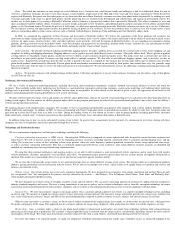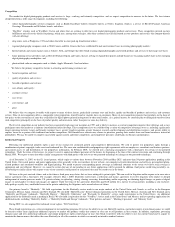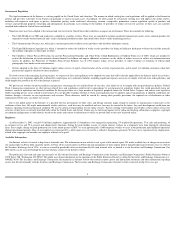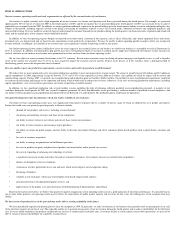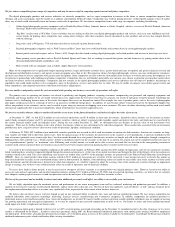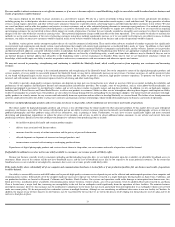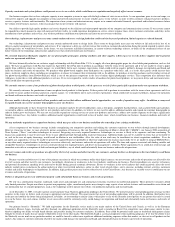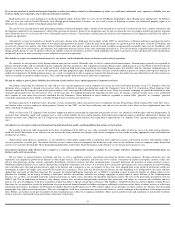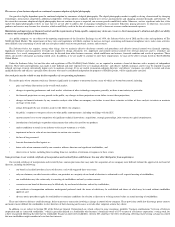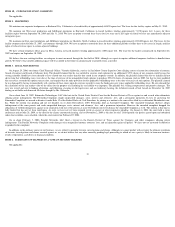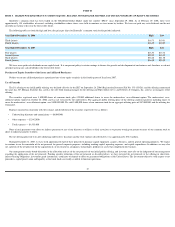Shutterfly 2008 Annual Report Download - page 18
Download and view the complete annual report
Please find page 18 of the 2008 Shutterfly annual report below. You can navigate through the pages in the report by either clicking on the pages listed below, or by using the keyword search tool below to find specific information within the annual report.
We face intense competition from a range of competitors and may be unsuccessful in competing against current and future competitors.
The digital photography products and services industries are intensely competitive, and we expect competition to increase in the future as current competitors improve their
offerings and as new participants enter the market or as industry consolidation further develops. Competition may result in pricing pressures, reduced profit margins or loss of market
share, any of which could substantially harm our business and results of operations. We face intense competition from a wide range of companies, including the following:
Many of our competitors have significantly longer operating histories, larger and broader customer bases, greater brand and name recognition and greater financial, research and
development and distribution resources, and operate in more geographic areas than we do. The numerous choices for digital photography services can cause confusion for consumers,
and may cause them to select a competitor with greater name recognition. Some competitors are able to devote substantially more resources to website and systems development, or to
investments or partnerships with traditional and online competitors. Competitors that are well-
funded, particularly new entrants, may choose to prioritize growing their market share
and brand awareness instead of profitability. Competitors and new entrants in the digital photography products and services industries may develop new products, technologies or
capabilities that could render obsolete or less competitive many of the products, services and content that we offer. We may be unable to compete successfully against current and
future competitors, and competitive pressures could harm our business and prospects.
If we are unable to adequately control the costs associated with operating our business, our results of operations will suffer.
The primary costs in operating our business are related to producing and shipping products, acquiring customers, compensating our personnel and acquiring equipment and
technology and leasing facilities. If we are unable to keep these costs aligned with the level of revenues that we generate, our results of operations would be harmed. Controlling our
business costs is challenging because many of the factors that impact these costs are beyond our control. For example, the costs to produce prints, such as the costs of photographic
print paper, could increase due to a shortage of silver or an increase in worldwide energy prices. In addition, we may become subject to increased costs by the third-
party shippers that
deliver our products to our customers, and we may be unable to pass along any increases in shipping costs to our customers. The costs of online advertising and keyword search could
also increase significantly due to increased competition, which would increase our customer acquisition costs.
We invest in securities that are subject to market risk and the recent issues in the financial markets could adversely affect the value of our assets.
At December 31, 2007, we had $122.6 million in cash and cash equivalents and $3.0 million in short-
term investments. Included in these amounts, are investments in money
market funds, commercial paper, and U.S. government agency securities, which are subject to general credit, liquidity, market and interest rate risks, and which may be exacerbated by
the current financial market credit and liquidity issues. During the year ended December 31, 2007, we determined that any declines in the fair value of our investments were
temporary. There may be further declines in the value of these investments, which we may determined to be other-than-
temporary. These market risks associated with our investment
portfolio may have a negative adverse effect on our results of operations, liquidity, and financial condition.
At February 29, 2008, $52.3 million of our marketable securities portfolio was invested in AAA rated investments in auction-rate debt securities. Auction-rate securities are long-
term variable rate bonds tied to short-
term interest rates. After the initial issuance of the securities, the interest rate on the securities is reset periodically, at intervals established at the
time of issuance (primarily every twenty-eight days), based on market demand for a reset period. Auction-
rate securities are bought and sold in the marketplace through a competitive
bidding process often referred to as a “Dutch auction”.
If there is insufficient interest in the securities at the time of an auction, the auction may not be completed and the rates may be
reset to predetermined “penalty” or “maximum” rates. Following such a failed auction, we would not be able to access our funds that are invested in the corresponding auction-
rate
securities until a future auction of these investments is successful or new buyers express interest in purchasing these securities in between reset dates.
As a result of the current negative liquidity conditions in the global credit markets, in February 2008, auctions for $42.3 million of original par value of our auction-
rate securities
failed, rendering these securities temporarily illiquid through the normal auction process. At the time of our initial investment and through the date of this Report, all of our auction-
rate
securities remain AAA rated. The assets underlying each security are student loans and 95% of the principal amounts are guaranteed by the Federal Family Education Loan Program
(FFELP). Since we cannot predict when future auctions related to $52.3 million of our auction-
rate securities will be successful, it may become necessary to classify this amount as
long-
term marketable securities in our consolidated balance sheet in future periods. In addition, if the underlying issuers are unable to successfully clear future auctions or if their credit
rating deteriorates and the deterioration is deemed to be other-than-temporary, we would be required to adjust the carrying value of the auction-
rate securities through an impairment
charge to earnings. Any of these events could materially affect our results of operations and our financial condition.
To access these funds in future periods, it may be necessary to attempt to sell these securities at an amount below our original purchase value. However, based on our ability to
access our cash and cash equivalents and our other liquid investments, totaling $53.7 million at February 29, 2008, and our expected operating cash flows, we believe that we currently
have adequate working capital resources to fund our operations and we do not expect to be required to sell these securities at a loss.
The loss of key personnel and an inability to attract and retain additional personnel could affect our ability to successfully grow our business.
We are highly dependent upon the continued service and performance of our senior management team and key technical, marketing and production personnel. In addition, a
majority of our executive team has recently joined Shutterfly, and has tenure of less than one year. The loss of these key employees, each of whom is “at will”
and may terminate his or
her employment relationship with us at any time, may significantly delay or prevent the achievement of our business objectives.
We believe that our future success will also depend in part on our continued ability to identify, hire, train and motivate qualified personnel. We face intense competition for
qualified individuals from numerous technology, marketing, financial services, manufacturing and e-
commerce companies. In addition, competition for qualified personnel is
particularly intense in the San Francisco Bay Area, where our headquarters are located. We may be unable to attract and retain suitably qualified individuals who are capable of meeting
our growing operational and managerial requirements, or we may be required to pay increased compensation in order to do so. Our failure to attract and retain qualified personnel
could impair our ability to implement our business plan.
Our evergreen option pool is limited to the lesser of a) 4.62% of stock options issued and outstanding on the December 31 immediately prior to the date of increase or b) a lesser
number as determined by the Board. , In order to attract key personnel, during 2007, the Board authorized additional inducement stock option grants totaling 380,000 to supplement
our option pool. In the future, attracting key personnel may require a level of option grants in excess of the amount available in our option pool. Accordingly the Board may authorize
additional inducement grants which could further dilute existing shareholders.
•
Online digital photography services companies such as Kodak EasyShare Gallery (formerly known as Ofoto), Snapfish, which is a service of Hewlett-
Packard, American
Greetings
’
Photoworks and Webshots brands, and others;
•
“Big Box” retailers such as Wal-Mart, Costco and others that are seeking to offer low cost digital photography products and services, such as in-store fulfillment and self-
service kiosks for printing; these competitors may, among other strategies, offer their customers heavily discounted in-
store products and services that compete directly
with our offerings;
•
Drug stores such as Walgreens, CVS and others that offer in
-
store pick
-
up from Internet orders;
•
Regional photography companies such as Wolf Camera and Ritz Camera that have established brands and customer bases in existing photography markets;
•
Internet portals and search engines such as Yahoo!, AOL, Google that offer broad
-
reaching digital photography and related products and services to their large user bases;
•
Home printing service providers such as Hewlett-
Packard, Epson and Canon, that are seeking to expand their printer and ink businesses by gaining market share in the
emerging digital photography marketplace; and
•
Photo
-
related software companies such as Adobe, Apple, Microsoft, Corel and others.



